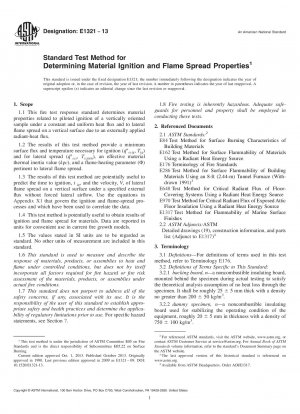ASTM E1321-13
Standard Test Method for Determining Material Ignition and Flame Spread Properties
- Standard No.
- ASTM E1321-13
- Release Date
- 2013
- Published By
- American Society for Testing and Materials (ASTM)
- Status
- Replace By
- ASTM E1321-18
- Latest
- ASTM E1321-18
- Scope
5.1 This test method addresses the fundamental aspects of piloted ignition and flame spread. The procedure is suitable for the derivation of relevant material flammability parameters that include minimum exposure levels for ignition, thermal-inertia values, and flame-spread properties.
5.2 This test method is used to measure some material-flammability properties that are scientifically constant and compatible and to derive specific properties that allow the prediction and explanation of the flame-spread characteristics of materials. They are considered effective properties that are dependent on the correlations used and when combined with theory can be used over a wide range of fire conditions for predicting material ignition and flame-spread behavior.
5.3 Do not use this test method for products that do not have planar, or nearly planar, external surfaces and those products and assemblies in which physical performance such as joint separation and fastening methods has a significant influence on flame propagation in actual fire conditions.
5.4 In this procedure, the specimens are subjected to one or more specific sets of laboratory test conditions. If different test conditions are substituted or the end-use conditions are changed, it is not always possible by or from this test method to predict changes in the fire-test-response characteristics measured. Therefore, the results are valid only for the fire test exposure conditions described in this procedure (see also 1.6).
1.1 This fire test response standard determines material properties related to piloted ignition of a vertically oriented sample under a constant and uniform heat flux and to lateral flame spread on a vertical surface due to an externally applied radiant-heat flux.
1.2 The results of this test method provide a minimum surface flux and temperature necessary for ignition ( q˙"o,ig, Tig) and for lateral spread ( q˙"o,s, Ts,min), an effective material thermal inertia value (kρc), and a flame-heating parameter (Φ) pertinent to lateral flame spread.
1.3 The results of this test method are potentially useful to predict the time to ignition, t ig, and the velocity, ......
ASTM E1321-13 Referenced Document
- ASTM E1317 Standard Test Method for Flammability of Marine Surface Finishes
- ASTM E162 Standard Test Method for Surface Flammability of Materials Using a Radiant Heat Energy Source
- ASTM E176 Standard Terminology of Fire Standards
- ASTM E286
- ASTM E648 Standard Test Method for Critical Radiant Flux of Floor-Covering Systems Using a Radiant Heat Energy Source
- ASTM E84 Standard Test Method for Surface Burning Characteristics of Building Materials
- ASTM E970 Standard Test Method for Critical Radiant Flux of Exposed Attic Floor Insulation Using a Radiant Heat Energy Source
ASTM E1321-13 history
- 2018 ASTM E1321-18 Standard Test Method for Determining Material Ignition and Flame Spread Properties
- 2013 ASTM E1321-13 Standard Test Method for Determining Material Ignition and Flame Spread Properties
- 2009 ASTM E1321-09 Standard Test Method for Determining Material Ignition and Flame Spread Properties
- 2008 ASTM E1321-08 Standard Test Method for Determining Material Ignition and Flame Spread Properties
- 1997 ASTM E1321-97a(2002)e1 Standard Test Method for Determining Material Ignition and Flame Spread Properties
- 1997 ASTM E1321-97a(2002) Standard Test Method for Determining Material Ignition and Flame Spread Properties
- 1997 ASTM E1321-97a Standard Test Method for Determining Material Ignition and Flame Spread Properties

Copyright ©2024 All Rights Reserved